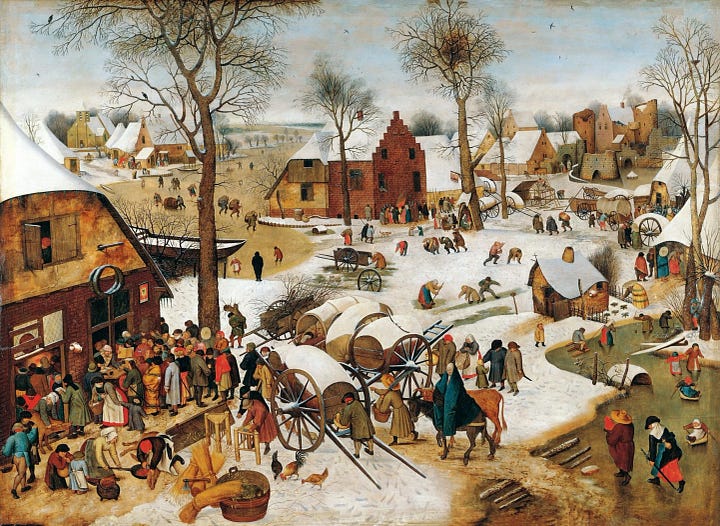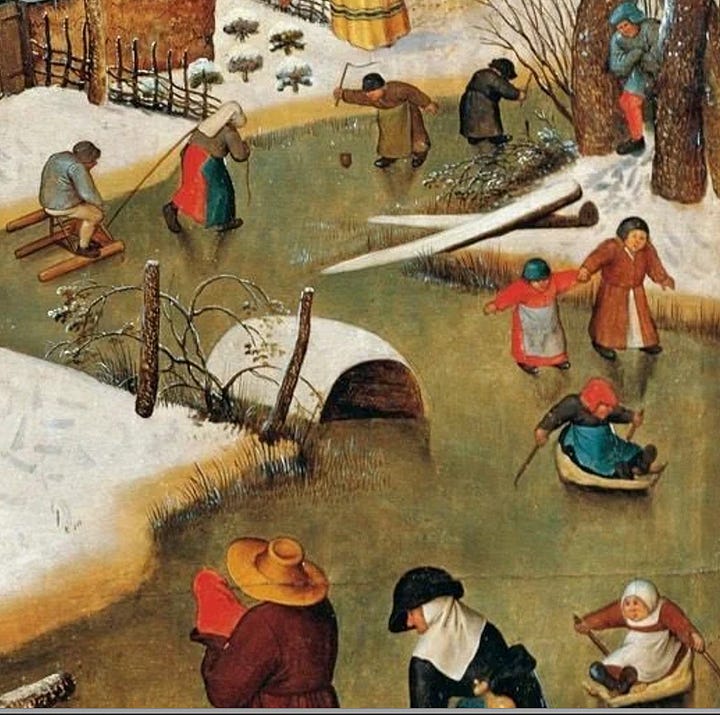
Sometimes the most familiar poems are the strangest. In W. H. Auden’s ‘Musée des Beaux Arts’, for instance, the poet uses old paintings to think about suffering’s ‘human position’, the way in which terrible things take place while the rest of the world gets on with its life. It is one of my favourite poems. I have read it countless times. But I never really thought about it as a poem about art, and looking at art, until I saw the paintings in person.
Perhaps this is only right. If poetry about art (also known as ekraphtic poetry) is going to work, it needs to work without you having the painting in front of you, or even having seen it. We can’t read and look at the same time. The poem’s combination of an off-hand tone and tightly-wound syntax conjures up both the human messiness of paintings like Breughel’s The Fall of Icarus and the moral Auden draws from them. The picture is in the words.
Then again, this isn’t so much a poem about paintings as a poem about being in a gallery. Specifically, being in the Musée royaux des Beaux Arts in Brussels. We are dropped into Auden’s thoughts as he ambles around the collection. It is like eaves-dropping on a particularly eloquent (or verbose) tour guide:
About suffering they were never wrong, The Old Masters: how well they understood Its human position...
Before I visited Brussels, the painting I most associated with Auden’s poem was Breughel’s The Fall of Icarus - that boy falling out of the sky in the final lines. Seeing that painting in person, I thought, would almost be like encountering the poem in person. I would be standing in Auden’s shoes. So, when I finally came around one corner in the gallery and caught a glimpse of Icarus, I decided I would start at the other end of the room: save that moment for the end.
Immediately, as I turned to the wall in front of me, I was confronted with the two other paintings in the poem. Auden doesn’t name them, but they provide the material for the first stanza; paintings I’d barely given a second thought to. Here, suddenly, was the poem, standing in front of me.


There were the ‘children skating’: the wonderful, silly squat little figures mucking around on the ice in The Numbering at Bethlehem. There, in The Massacre of the Innocents, was the ‘dreadful martyrdom’: soldiers butchering babies with pikes, while more go door to door and a small body lies in the snow.
In The Massacre (which the Brueghels made several versions of) an event from the New Testament is transposed into a 16th century Flemish village. Herod has ordered that all the children under the age of two in Bethlehem should be killed. The soldiers are Spanish troops and German mercenaries. It is bitterly cold and the roofs are iced like Christmas cakes. The Dutch will soon rebel against the Hapsburgs. We know that this is the spark for Auden’s comment about ‘suffering’ because of the pair of dogs just to the right of the violence taking place in the centre. They are so close to the action. They are playfighting. They are, in Auden’s words, getting on with their ‘doggy life’. The poem doesn’t mention these detais (and there are other dogs) but, once you see them, they feel inevitable.
Elsewhere, Auden seems to use his imagination: none of the paintings provide an exact model for the ‘torturer’s horse’. In an essay in 1963, Arthur Kinney suggested the most likely candidate was one towards the front of the painting, since it is the only one both with a rider and near a tree. I wonder if Auden wasn’t also thinking of the horses at the back of the scene, behind the playing dogs. They stand with their heads to the trees they’re tied to, as if they can’t bear to look at what is happening behind them.


The Massacre is just one picture. Reading the poem again, it’s surprisingly difficult to marry what it announces it is about - that is, suffering - and what is happening in the others. The skating children are missing something important (the registration of the baby Jesus) but The Numbering at Bethlehem is only about suffering in the sense that any depiction of Jesus would, for medieval viewers, bring to mind the Crucifixion. In fact I think it is a stretch to describe The Fall of Icarus as about suffering, either. Icarus drops out of the sky, but he isn’t suffering long. Whenever I read that story always think the sufferer is Icarus’s father.
In short, if ‘Musée des Beaux Arts’ is about any one painting it isn’t The Fall of Icarus, it’s The Massacre of the Innocents: everything Auden thinks and feels, including his response to Icarus, is coloured by that one painting. But Auden isn’t only responding to a painting. This is December 1938. He has seen the civil war in Spain and just returned to Europe from reporting on the war in China. He knows what is happening in Germany. So there is another message, which only becomes clear when you take a step back: suffering is also something that takes place while someone else is moseying around a gallery, looking at paintings.




This is, as ever, both readable and insightful. I first read ‘Musée des Beaux Arts’ many, many years ago, and for a long time thought it was just about one painting in particular, not a number of them. It took listening to Frank Skinner’s poetry podcast on it for the penny to
drop. Which is worth a listen.
Love reading about the interplay of art, the written word, and history